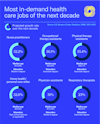 Katie Mahoney
Katie Mahoney
Former Vice President, Health Policy, U.S. Chamber of Commerce
Published
January 29, 2024
The United States is currently grappling with a nursing shortage that is causing a ripple effect of rising health care costs and lower quality of life across the country. Lingering nurse burnout from the pandemic, an aging population, inadequate nursing school capacity, and prolonged delays in employment-based immigration have left significant gaps. Recognizing the gravity of the situation, the U.S. Chamber offers vital insights in the following data deep dive on the nursing shortage.
-
193,100
Projected job openings for registered nurses (RNs) on average per year until 2032.
However, for the decade between 2022-2032, the United States expects only an additional 177,400 nurses to enter the workforce, which is less than what is needed to fill one year of projected openings.
-
1.6%
Nursing unemployment rate*
-
3.7%
National unemployment rate**
*As of 2022
**As of December 2023
From 2020 to 2021, the number of registered nurses in the workforce decreased by over 100,000, marking the most substantial decline in the last forty years. A considerable portion of these departing nurses were under 35 years old, with the majority being previously employed within hospital settings.

Nursing has a low unemployment rate—and is therefore a very stable occupation—compared to most professions. Almost 99% of individuals with nursing expertise and training actively seeking employment are able to secure jobs.
And yet, while nurses continue to enter or come back into the workforce after the COVID-19 pandemic, our nation still faces an extreme nursing shortage.
9 nurses: 1,000 people
There is an average of nine RNs in the U.S. for every 1,000 people. Utah, Georgia, and Texas have the lowest nursing ratio with just seven RNs for every 1,000 people. Inadequate levels of nursing staff contribute to errors and elevated mortality rates, along with heightened burnout and dissatisfaction among nurses.

By the year 2030, it is expected that 42 out of the 50 states in the United States will likely experience shortages in nursing staff. Notably, North Dakota, Colorado, Texas, Florida, and Nevada are among the states anticipating the most pronounced nursing shortages, with North Dakota projected to meet only 84% of its nursing demand.
On the flip side, Vermont, Maine, Rhode Island, West Virginia, Alabama, Pennsylvania, Connecticut, and New Hampshire are forecasting an excess supply of nurses in 2030, according to National Center for Health Workforce Analysis.
Nursing shortage leads to hospital closures
The lack of available nurses is one major contributing factor to the rise of hospital closures in recent years across the United States. According to Becker's Hospital Review, 42 medical centers have closed medical departments or ended services at facilities since February 2023.
In June 2023, there were 293 rural hospitals at risk of immediate closure. At the forefront of the risk chart are Kansas and Texas, with both states facing the immediate potential loss of 29 hospitals. Given their widely dispersed populations, hospital closures in these regions could have devastating impacts on local businesses and economy.
When a hospital closes, not only does the area lose a major employer, but it loses a significant component of the community’s infrastructure which can deter other businesses from considering the location for expansion or investment. The closure of hospitals can create a ripple effect in the local economy, leading to reduced employment opportunities, decreased consumer spending, and diminished demand for goods and services. This all adversely affects the revenue and vitality of local businesses.
Where is this shortage coming from?
Low retention rates
The turnover rate for nursing spans from 8.8 percent to as high as 37.0 percent, depending on the region and nursing specialty. In fact, more than half of nurses leave their job within the first two years. That compares to a median job tenure across all industries of four years.

Nurses have voiced significant concerns about their line of work including lingering pandemic burnout, demanding work environments, a sense of being undervalued, and concerns related to compensation.
A 2022 study of over 50,000 RNs and licensed practical nurses/licensed vocational nurses revealed nurses felt the following "a few times a week" or "every day:"
- a sense of depletion (56.4%)
- emotional exhaustion (50.8%)
- fatigue (49.7%)
- burnout (45.1%)
It's worth highlighting that between 2012 and 2021, the number of RN positions increased by 9.1%, while travel RN positions experienced substantial growth, reaching 15.9% during the same period. This growth can be attributed to the fact that some of the challenges associated with the job are alleviated by competitive salaries, increased opportunities for travel, and greater scheduling flexibility between contracts.
An education gap
Every academic year, nursing programs turn away tens of thousands of qualified applicants. These aspiring nurses aren't being denied admission due to their inability to meet entry requirements; rather, there are not enough nurse educators to train them. The lack of educators is limiting the ability of educational institutions to fully enroll and train a robust pipeline of new nursing students.

In a recent survey conducted by the National League for Nursing, it was found that 86 percent of the responding nursing schools were actively looking to hire new faculty members, and more than 80 percent acknowledged ongoing challenges in the faculty recruitment process, which are elaborated on below.

Also impacting nursing program enrollment levels are factors such as a shortage of clinical sites, classroom space, clinical preceptors, and budget limitations.
On a positive note, there continues to be a steadfast interest among individuals seeking to enter the nursing profession. Lawmakers have also shown a commitment to tackling the nationwide shortage of nurse practitioners and nurse educators by putting forth a range of legislative proposals in the past, offering hope for a bipartisan resolution in the future.
An aging population
Currently, the U.S. has more Americans over the age of 65 than at any other time in history. By 2030, all Baby Boomers will have reached retirement age, leading to increased need in health care services.
Nurses are part of this demographic retirement wave, with approximately one million nurses 50 years or older, and nearly 60 percent of nurses over the age of 40. Furthermore, over 20 percent of nurses plan to retire within the next five years, adding to the depletion of the current nursing faculty pool.
Inadequate employment-based immigration options
Currently, legal immigrants represent more than 18 percent of the health care workforce. They contribute substantially to our nation’s pool of health care workers, particularly in home health aide roles. Given the absence of an immediate solution to the challenges of an aging population and the shortage of health care educators, qualified international nurses and health aides have become essential to the industry.

However, employment-based immigration options for international nurses are limited and very complex. Compared to workers in other industries, they have fewer visa options available to them. Oftentimes, it will take years for foreign national nurses to obtain the visa they need to work in the U.S. American health care providers need this critical talent today.
The Chamber is calling on Congress to take action this year fix our broken immigration system. The types of changes we’re calling for that would help American health care providers meet their staffing needs include substantially raising the annual quotas for employment-based immigrant and nonimmigrant visas, expanding the scope of essential worker programs, and creating new visa options for high-demand workers.
Taking Action on Bipartisan Immigration Reform
The Legal Immigration and Border Enforcement Reform This Year (LIBERTY) Campaign was formed to call upon Congress to enact measures to improve border security and our legal immigration system.
The future of health care
In the coming decade, three of the most sought-after health care occupations – nurse practitioners, occupational therapy assistants, and physical therapy assistants – will require a nursing degree of some kind, highlighting the urgent need to increase the capacity and accessibility of nursing degree programs. Those who do acquire a nursing degree can earn salaries exceeding the U.S. median annual income of $61,600, with nurse practitioners earning $111,000 or more annually.

While nursing remains one of the most challenging health care roles to fill, it’s not the only role facing workforce challenges. There is a widespread worker shortage across the health care industry. The latest data on the top ten hard-to-fill health care jobs is from 2018, and the shortage is likely higher today after the COVID-19 pandemic exacerbated nurse burnout.

Conclusion
The nursing crisis calls for immediate attention and action. This shortage results from various factors, necessitating a multi-pronged approach. We must strengthen the nursing pipeline by mitigating educational gaps, while also managing retention, burnout, and immigration challenges.
The U.S. Chamber is committed to helping ease worker shortages across all impacted industries including health care, and helping employers develop and discover talent to fill open jobs and grow our economy. The America Works Initiative has workforce solutions, resources, and guides for employers.
For example, the U.S. Chamber Foundation’s Talent Pipeline Management (TPM) program helps partner employers, including hospitals, with community leaders in education and economic development to make sure future workers are learning the right skills to fill community needs.
In 2023, the U.S. Chamber—together with over 430 business associations from all 50 states—launched the (LIBERTY) Campaign to call on elected officials to secure our borders and update our broken legal immigration system.
Learn More
- Bringing Employers Together to Solve Talent Challenges in the Healthcare Industry
- Investing in Apprenticeships to Expand the Pool of Nurses for Vermont Hospitals
Read More
About the authors

Makinizi Hoover
Makinizi Hoover is Housing Policy Lead at the U.S. Chamber of Commerce, where she leads the Chamber’s work to advance supply-side reforms that improve housing affordability and availability.

Isabella Lucy
Isabella has created stunning visualizations tackling pressing issues like the worker shortage, the benefits of hiring veterans, the lifespan of small businesses, and the future of work.

Katie Mahoney
Katie W. Mahoney is the former vice president of health policy at the U.S. Chamber of Commerce.






